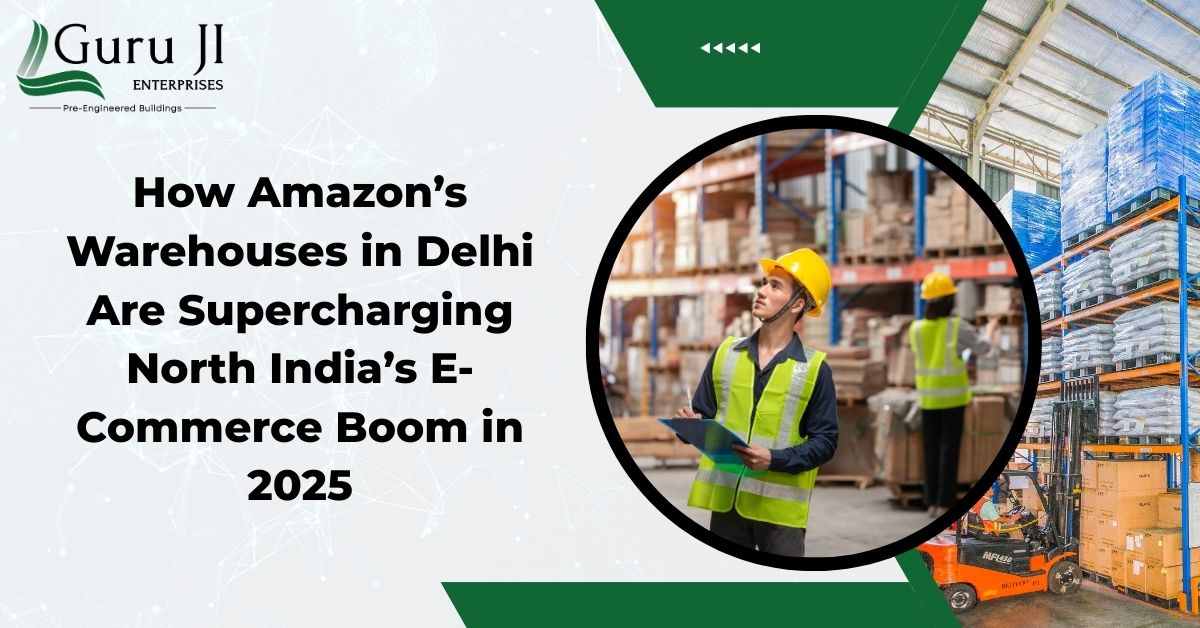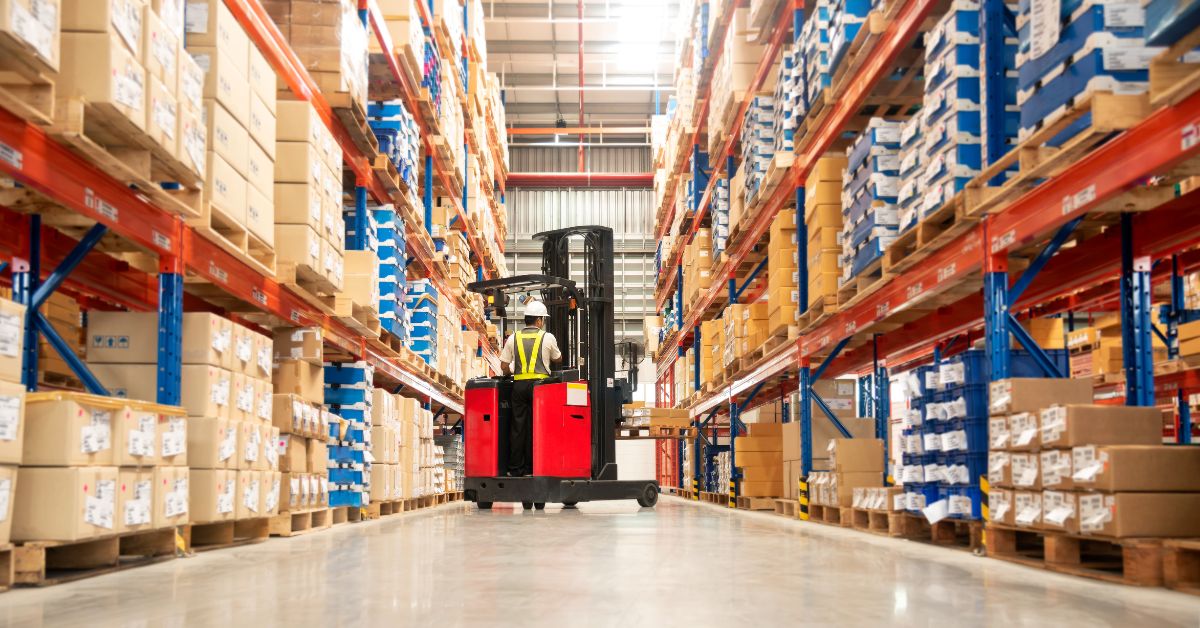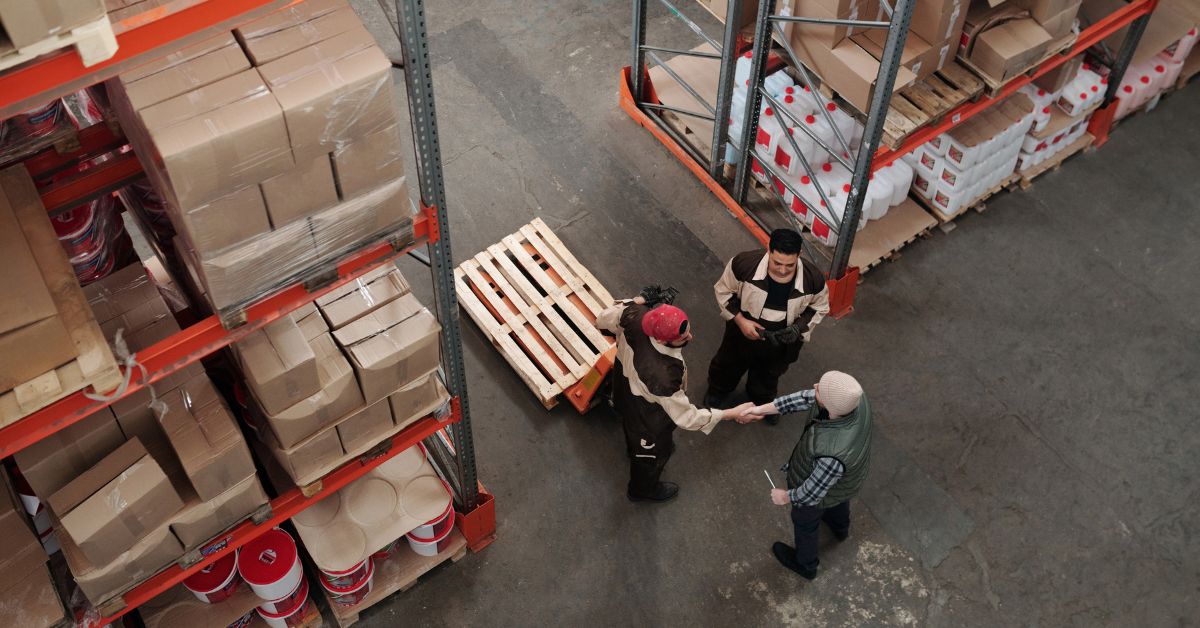
By 2025, the e-commerce industry in India has transformed and is now strongly developed, mainly in the northern area. Businesses selling online such as Amazon, are revamping their physical infrastructure to meet the ever-increasing needs of people buying online. Cutting-edge Amazon warehouses developed in Delhi are a major part of the logistical revolution moving forward. Not only are these places storage rooms—they are high-tech centers that handle fulfillment, are expandable and change the way goods are distributed in North India. The change we see today is largely propelled by Guruji Infrastructure which is well known for its prowess in industrial building products. Because they successfully complete Amazon’s warehouse projects on time, on budget and with accuracy, they have helped the region’s e-commerce grow.
The Rise of E-Commerce in North India
North India, mainly in the Delhi NCR region, is now critical to giants like Amazon in e-commerce. As more people live in cities, more people use the internet and demand for fast delivery grows, companies need better warehouse systems.
From 2020 to 2025, there was a 30% CAGR increase in online retail in this region. Figure City Now Delhi, Gurugram, Noida and Ghaziabad act as important consumer areas and main points for distributing products across India. For this rapid expansion, Amazon warehouses in Delhi have transformed into advanced centers that look after everything from stock to the last stage of delivery.
Strategic Importance of Amazon’s Warehouses in Delhi
Apart from being central, Delhi is also where many strategic decisions about Amazon’s logistics are made. The city is the main connection for warehousing and distribution in northern India, extending to important cities and smaller towns in Haryana, Punjab, Rajasthan and Uttar Pradesh.
Here’s why the Amazon warehouse in Delhi is vital:
- Proximity to High-Demand Areas: Helps send items faster and delivery times become quicker.
- Logistics Connectivity: The presence of numerous highways, railroads and air cargo sites.
- Business Ecosystem: Assists companies handling logistics and packaging.
Key Features of Amazon Warehouses in India

Amazon’s warehouses are designed to ensure operational excellence, scalability, and sustainability. These facilities are far from conventional storage units; they are technology-integrated, process-optimized hubs built to Amazon’s global standards.
Features:
- Automated Sorting and Packing Systems
- Real-time Inventory Management via IoT & AI
- Climate-Controlled Zones for Sensitive Goods
- Energy-Efficient LED Lighting and Solar Integration
- Fire-resistant and Seismically Resilient Structures
- Flexible Layouts for Dynamic Product Volumes
All these features enable Amazon warehouse services in Delhi to deliver a consistently superior customer experience through faster deliveries, reduced order errors, and optimized manpower deployment.
How Amazon Warehouse Services in Delhi Are Driving Efficiency
There’s more to Amazon warehouse services than just storing items. At such centers, orders are handled precisely and very fast, even with a high volume of packages. Through its warehouses in Delhi, Amazon can now provide same-day and next-day deliveries, seen as standards in the industry.
Key operational efficiencies include:
- Speed to Market: Improved delivery times for popular items in electronics, apparel and grocery.
- Reverse Logistics: Easy procedures for returning and changing products.
- Last-Mile Delivery Optimization: Integration with local delivery partners and Amazon Flex drivers.
- Data Analytics: Predictive tools help in inventory forecasting and demand planning.
These capabilities are made possible by modern infrastructure and smart facility design—a domain where Guruji Infrastructure has been instrumental.
Role of Advanced Infrastructure in Supporting Amazon's Vision
There is more to making a large warehouse than just building four walls. For this to work, engineering expertise, being cost-efficient and fast action are all needed. This is crucial for Amazon since putting anything other than top priority ahead is not allowed in their operations.
Why infrastructure matters:- Faster Deployment: It is very important to deploy new ideas quickly in an industry where consumer habits change rapidly.
- Customization: They must be able to handle changing products and various storage requirements.
- Regulatory Compliance: All buildings are required to fulfill local and national safety rules and regulations.
- Environmental Protection: The group uses methods that are friendly to nature to meet global ESG standards.
- Sustainability: It is companies such as Guruji Infrastructure impress by designing tailor-made answers to all these requirements.
This is where companies like Guruji Infrastructure shine—offering engineered solutions that check all these boxes.
How Guruji Infrastructure Delivered Amazon Warehouses Seamlessly

Founded in 2012 and certified under ISO 9001:2015, Guruji Infrastructure has become a trusted name in India’s industrial building sector. Their reputation for precision, punctuality, and professionalism has earned them a seat at the table for landmark projects like Amazon’s warehouses in Delhi.
Here’s how Guruji Infrastructure made it possible:
- Pre-Designed Engineering: All warehouse components were engineered and fabricated in a controlled environment, ensuring uniform quality and precision.
- Zero Labor Delays: Manufacturing under controlled conditions minimized dependency on site labor, a common bottleneck in Indian construction
- Budget Efficiency: Controlled costs by eliminating wastage, rework, and material shortages.
- Rapid Delivery: Projects were delivered ahead of schedule, meeting Amazon’s tight deadlines.
- Quality Assurance: Rigorous checks ensured each element met structural, operational, and safety benchmarks.
This streamlined approach to infrastructure delivery has helped Amazon maintain high operational efficiency in its warehousing operations in North India.
Future Outlook: What’s Next for Amazon Warehousing in India?
The future of warehousing in India is about hyper-automation, regional micro-fulfillment centers, and green logistics. Amazon is expected to increase its footprint with more smart warehouses, and cities like Delhi will continue to serve as the fulcrum of this growth.
Emerging Trends:
- Robotics & AI Integration: For automated picking, packing, and movement.
- Vertical Warehousing: Maximizing space in dense urban areas.
- Decentralized Fulfillment Centers: To serve Tier-II and Tier-III cities more efficiently.
- Green Warehousing Practices: Water recycling, solar power, and low-carbon construction materials.
Companies that can offer flexible, scalable, and sustainable solutions, like Guruji Infrastructure, will be central to this transformation.
Conclusion
North India’s rise in e-commerce due to Amazon involves much more than technology—it is also about improving logistics and infrastructure. Because more people want their orders delivered and returned quickly and because many items are temperature-sensitive, modern warehousing is extremely important.
The warehouse in Delhi is proof that bringing location, design, and execution together can completely redefine an industry. No part of this could take place without help from our trusted infrastructure partners.
Guruji Infrastructure has played an important role, providing highly qualified buildings that follow international standards. Thanks to their skill in warehouse planning and implementation, Amazon now leads the way in operational achievement.
The more India’s e-commerce ecosystem develops, the more it will look to companies like Guruji Infrastructure to design the future with greater speed, intelligence, and attention to the environment.